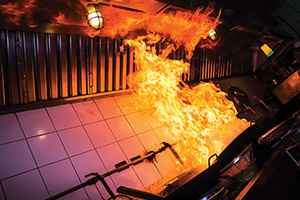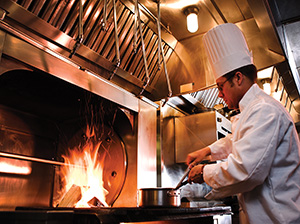Essential fire safety checklist for new restaurants.
By Billy Findley
Building a new restaurant can be overwhelming. From permits to hiring to creating the menu — there are an immense amount of things that must be done, which can cause facility managers many challenges. One of the most important deals with the safety of employees and guests.
 On top of keeping everyone safe, everything also must be done to specific government-set codes. These codes regulate many inspections and trainings that happen for the lifetime of the restaurant, but many of the codes revolve around the building of a new restaurant.
On top of keeping everyone safe, everything also must be done to specific government-set codes. These codes regulate many inspections and trainings that happen for the lifetime of the restaurant, but many of the codes revolve around the building of a new restaurant.
The easiest way to ensure accuracy throughout a new build is to have a checklist, preferably one for an install and a final version before your restaurant plans to open. If you aren’t already consulting with a professional in fire and life safety, consider doing so. Use these tips to help you get started.
Site Readiness for Install Checklist
- Hood installed.
- Electrical power to all appliances, outlets under the hood, hood and controls.
- Gas valve installed and accessible.
- Ceiling accessibility above hood.
- Pull station location established. Code requires no closer than 10 feet and no farther than 20 feet in the path of egress, and 42 inches to 48 inches above the finished floor. If the pull station is recessed, then the electrician has mounted an octagon box in appropriate location with a half-inch conduit running to top plate.
- Equipment is on-site and in an appropriate location under the hood.
- Wall finished where wall mounted system will be mounted if not in an end cabinet. This would include painted wall or tile.
 Once these steps have been completed, you’re ready for a final inspection.
Once these steps have been completed, you’re ready for a final inspection.
Site Readiness Final
Acceptance Test Checklist
- Makeup air fan or HVAC connection if applicable is connected to the kitchen fire suppression system so that it will shut down at time of system discharge.
- Electrical power to all appliances and outlets under the hood most shut off at the time of system discharge.
- Exhaust fan must remain on when system discharges, or come on if switch is in off position or other special requirements must be met. Heat detector/probe in and connected to the fan controls.
- Kitchen fire suppression system must be connected to the building fire alarm, if provided. Fire alarm must be capable of testing at the time of the test to confirm this.
- Gas must be turned on, equipment connected and pilots lit so the inspector can see them turn off at time of system discharge.
- Have appropriate K class fire extinguisher and appropriate ABC fire extinguishers.
- Heat detector connected to hood and functional. A room temperature sensor needs to be installed if provided.
Any final acceptance test that fails because of any of the above items are incomplete when the technician arrives will have to be re-tested. With safety and code compliance top of mind, using a checklist similar to these will help ensure that your restaurant gets off the ground as quickly as possible.
— Billy Findley is vice president of general products at Koorsen Fire and Security. Family-owned and founded in Indianapolis in 1946, the company has since expanded its reach, now serving 28 markets.
